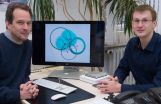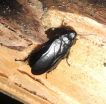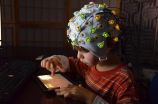A 'GPS' for molecules
Researchers at the University of Bonn are developing novel methods for exploring the structure of enzymes
2014-12-19
(Press-News.org) In everyday life, the global positioning system (GPS) can be employed to reliably determine the momentary location of one en route to the desired destination. Scientists from the Institute of Physical and Theoretical Chemistry of the University of Bonn have now developed a molecular "GPS" with which the whereabouts of metal ions in enzymes can be reliably determined. Such ions play important roles in all corners of metabolism and synthesis for biological products. The "molecular GPS" is now being featured in the journal Angewandte Chemie.
There would be no life on our planet without enzymes. These molecules, control and enable biochemical reactions ranging from digestion to the duplication of genetic information. "Enzymes are spatially complex structures which can have multiple folds, sheets and loops", says Prof. Dr. Olav Schiemann from the Institute for Physical and Theoretical Chemistry of the University of Bonn. In the reaction center of such a "protein knot", which is known as the "active center", is often one or more metal ions. This means that the substance which is to be changed by a chemical reaction attaches to or close to the metal ion. The ion facilitates the breakage or reformation of one or more bonds in the attached substance and the conversion into a new substance arises through the enzyme. Such conversions take place constantly in our stomach, for example, where food is broken down into substances which our body can easily absorb.
Scientists are examining how such essential enzymes work. To do this, they must precisely know how the individual atoms are arranged in these biomolecules. "When we know the whereabouts of the metal ion in an enzyme, we can better understand exactly how the reactions proceed," says Prof. Schiemann. His working group has now determined the position of the active center in an enzyme using a novel method which is reminiscent in principle of the global positioning system (GPS) with which automobile navigation systems work.
Like the maze of traffic during rush hour
"The structure of enzymes is frequently, at first glance, just as confusing as the maze of traffic during rush hour," chuckles the physical chemist from the University of Bonn. Similarly to how an individual car is nearly impossible to make out in a large amount of traffic, the metal ion "hides" in the numerous coils and folds of the enzyme. Nonetheless, the position of the vehicle - and also that of the metal ion - can be reliably determined with GPS. Several satellites orbit our planet and indicate through the transit time of signals the distance to a certain point on the earth, for example, a car. The site where the distance spheres of the various satellites intersect is where the car to be located.
The "satellites" consist of the spin labeled amino acid cysteine
The physical chemists from the University of Bonn proceeded similarly. "Our satellites are spin labels," explains doctoral student Dinar Abdullin. These are small organic molecules which have an unpaired electron and which are stable. The researchers distributed six of these "molecular satellites" in their enzyme model "azurine" - a blue protein with a copper ion in the center. Using computer programs, the scientists first tracked the "orbits" of the tiny satellites in the coils of the enzyme. They then determined the distance between the satellites and the metal ion using a spectroscopic method, namely PELDOR, which acts like a ruler on a molecular level. "Similar to the GPS, we were able to precisely determine the position of the active center in the enzyme from this," says Abdullin.
The tool kit of physical chemistry has now gained an elegant additional method. "We developed the method for basic research but it can also be used to clarify the structure of other enzymes," says Prof. Schiemann. A better understanding of substance conversions at active centers is ultimately also the foundation, for example, for industrial drug manufacturing.
INFORMATION:
Publication: Abdullin D., Florin N., Hagelueken G. and Schiemann O.: EPR based Approach for the Localization of Paramagnetic Metal Ions in Biomolecules, Angewandte Chemie, DOI: 10.1002/anie.201410396
Media contact information:
Prof. Dr. Olav Schiemann
Institute of Physical and Theoretical
Chemistry of the University of Bonn
Tel. ++49-(0)228-732989
E-Mail: schiemann@pc.uni-bonn.de
[Attachments] See images for this press release:

ELSE PRESS RELEASES FROM THIS DATE:
2014-12-19
Bethesda, MD (Dec. 19, 2014) -- A new formulation of oral budesonide suspension, a steroid-based treatment, is safe and effective in treating pediatric patients with eosinophilic esophagitis (EoE), according to a new study in Clinical Gastroenterology and Hepatology, the official clinical practice journal of the American Gastroenterological Association. Eosinophilic esophagitis is a chronic immune system disease caused by a buildup of white blood cells in the lining of the esophagus. This build up, which is a reaction to food, allergens or acid reflux, can inflame or injure ...
2014-12-19
The changes can be measured, but their reasons were unknown. For several decades, scientists have carefully observed that the oxygen minimum zones (OMZ) in the tropical oceans are expanding. These zones are a paradise for some specially adapted microorganisms, but for all larger marine organisms such as fish and marine mammals they are uninhabitable. Thus, their expansion has already narrowed down the habitat of some fish species.
Marine scientists from the GEOMAR Helmholtz Centre for Ocean Research Kiel and the Kiel Collaborative Research Centre (Sonderforschungsbereich, ...
2014-12-19
PITTSBURGH--University of Pittsburgh researchers have shared their findings from three studies related to shale gas in a recent special issue of the journal Energy Technology, edited by Götz Veser, the Nickolas A. DeCecco Professor of Chemical and Petroleum Engineering in Pitt's Swanson School of Engineering.
In the special issue focusing on shale gas, Pitt faculty authors look at "smart wells" that use wireless communication, wastewater management, and information gaps between legislators, regulators, industry representatives, researchers, and the public on the ...
2014-12-19
Scientists from the Southwest University, Chongqing, China have found a new species and a new subspecies of cockroach. What makes these creepy crawlies distinctive from the cockroaches most of us know is that they don't infest human houses, on the contrary they prefer to live a hermit life drilling logs, hidden away from human eyes. The study was published in the open access journal ZooKeys.
Out of around 4,600 species worldwide, only 30 are the cockroaches associated with human habitats that gives the bad fame of these creatures. The representatives of the genus Panesthia, ...
2014-12-19
Most parents are not surprised by the irregularity of a newborn infant's sleep patterns, but by six months or so many parents wonder if something is wrong with their baby or their sleeping arrangements if the baby is not sleeping through the night. Healthcare providers, specifically nurse practitioners, can help parents understand what "normal" sleep patterns are for their child, according to researchers.
"Nurse practitioners are at the frontline of healthcare," said Robin Yaure, senior instructor of human development and family studies, Penn State Mont Alto. "They are ...
2014-12-19
Jacksonville, FL (December 19, 2014) - Investigators have found that young children with type 1 diabetes (T1D) have slower brain growth compared to children without diabetes. A new study, published in the December issue of Diabetes, now available ahead of print, suggests that continued exposure to hyperglycemia, or high blood sugars, may be detrimental to the developing brain. The research was supported by the National Institutes of Health (NIH).
"Our results show the potential vulnerability of young developing brains to abnormally elevated glucose levels, even when ...
2014-12-19
(MEMPHIS, Tenn. - DECEMBER 18, 2014) A study led by St. Jude Children's Research Hospital scientists has identified the population of white blood cells that tumors use to enhance growth and suppress the disease-fighting immune system. The results, which appear in the December 18 edition of the scientific journal Immunity, mark a turning point in cancer immunology and provide the foundation for developing more effective immunotherapies.
For years, researchers have known that a diverse group of white blood cells called myeloid-derived suppressor cells (MDSC) are more abundant ...
2014-12-19
In a previous randomized controlled trial, Stanford University researchers developed two curricula for Girl Scouts to use energy more efficiently: one on energy use at home, and the other in transportation and food. Both courses were effective for girls in the short term, and the home energy course was effective for girls in the long term and for parents in the short term.
Subsequently, the Northern California Girl Scouts began disseminating the programs via manuals and reusable materials, but that method of disseminating the programs has not lead to widespread use.
On ...
2014-12-19
[Boston, MA December18, 2014] Parents of children involved in an elementary school-based community intervention to prevent obesity appear to share in its health benefits. A new analysis of Shape Up Somerville: Eat Smart Play Hard™ shows an association between being exposed to the intervention as a parent and a modest decrease in body mass index (BMI) compared to parents in two similar control communities. The study led by researchers at the Friedman School of Nutrition Science and Policy at Tufts University and the Centers for Disease Control and Prevention (CDC) ...
2014-12-19
University of Chicago developmental neuroscientists have found specific brain markers that predict generosity in children. Those neural markers appear to be linked to both social and moral evaluation processes.
There are many sorts of prosocial behaviors. Although young children are natural helpers, their perspective on sharing resources tends to be selfish. Jean Decety, the Irving B. Harris Professor of Psychology and Psychiatry, and Jason Cowell, a postdoctoral scholar in Decety's Child NeuroSuite lab, wanted to find out how young children's brains evaluate whether ...
LAST 30 PRESS RELEASES:
[Press-News.org] A 'GPS' for molecules
Researchers at the University of Bonn are developing novel methods for exploring the structure of enzymes



